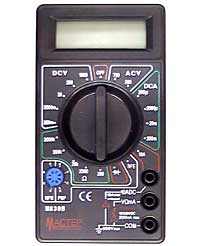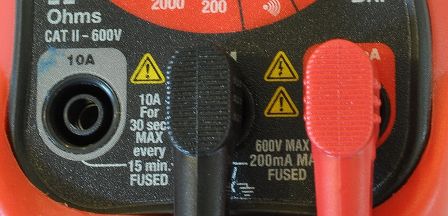How to choose a multimeter
 Twenty years ago, the most sophisticated device of this type could measure current, voltage and resistance (hence the old name - ammeter). And even despite the general digitalization of multimeters, their older analog brothers have not yet given up their positions — in some cases they are still indispensable (for example, for a quick qualitative assessment of parameters or for measurements in conditions of radio interference). Also, they only need power when measuring resistance, and even then not always, as some multimeters have a built-in dynamo for this purpose.
Twenty years ago, the most sophisticated device of this type could measure current, voltage and resistance (hence the old name - ammeter). And even despite the general digitalization of multimeters, their older analog brothers have not yet given up their positions — in some cases they are still indispensable (for example, for a quick qualitative assessment of parameters or for measurements in conditions of radio interference). Also, they only need power when measuring resistance, and even then not always, as some multimeters have a built-in dynamo for this purpose.
Now the concept «Multimeter» more accurately reflects the purpose of this multifunctional device. The number of varieties available is so great that every engineer can find a device that exactly meets his specific requirements, both in terms of the type and range of measured values, and in terms of a set of service functions.
In addition to the standard set of values (DC and AC voltage and strength, as well as resistance), modern multimeters allow measuring capacitance and inductance, temperature (using internal sensor or external thermocouple), frequency (Hz and rpm) and pulse duration and interval between pulses in case of a pulsed signal. Almost all of them can perform a continuity test (checking the continuity of a circuit with an audible signal when its resistance is below a certain value).
Very often they perform such functions as checking semiconductor devices (voltage drop across the pn junction, amplification of transistors) and generating a simple test signal (usually a square wave of a certain frequency). Many of the latest models have the computing power and a graphical display to display the waveform, albeit at a low resolution. At SPIN you can always find a device with the features you are interested in.
Among the service functions, special attention is drawn to the shutdown timer and the rather rare, but sometimes indispensable display backlight. Automatic selection of the measurement range is popular — in most of the latest models of multimeters, the mode switch serves only to select the measured value, and the device determines the measurement limit itself. Some simple models do not have such a switch at all. It should be noted that in some cases such "reasonable" behavior of the device can be inconvenient.
Capturing (saving) readings is very useful. Most often it is done by pressing the corresponding key, but some devices allow you to automatically record any stable and non-zero measurement. Intermittent short-circuits or circuit openings (triggering) in continuity mode are sometimes possible.
Powerful digital processors allow you to calculate the true RMS value of the measured signal with or without higher harmonics. Such devices are more expensive, but only they are suitable for diagnosing problems in electrical networks with non-linear loads. The fact is that conventional digital multimeters measure the average value of the signal, but based on the assumption of a strict sinusoidal shape of the measured signal, they are calibrated to show the average value. This assumption leads to errors in cases where the measured signal has a different shape or is a superposition of several sinusoidal signals or a sinusoid and a constant component. The size of the error depends on the waveform and can be quite significant (tens of percent).
Digital processing of measurement results is required much less frequently: when retaining maximum (peak) values, when recalculating values according to Ohm's law (for example, voltage is measured across a known resistor and current is calculated), with relative measurements with calculation per dB, as well as when storing several measurements with calculation of the average value for several readings.
For engineers, the characteristics of multimeters such as resolution and accuracy are important. There is no direct connection between them. The resolution depends on the bit depth of the ADC and the number of symbols displayed on the display (typically 3.5; 3.75, 4.5 or 4.75 for wearables and 6.5 for desktops). But no matter how many characters the display has, the accuracy will be determined by the characteristics of the multimeter's ADC and the calculation algorithm. The error is usually stated as a percentage of the measured value.For portable multimeters, it ranges from 0.025 to 3%, depending on the type of measured value and the class of the device.
Some models have both dial and digital indicators. The indicator with two digital scales is very convenient for displaying the second simultaneously measured or calculated value during the measurement. But the indicator is even more useful where there is an analog (bar) scale along with the digital one. Digital multimeters typically use relatively slow but accurate and noise-resistant ADCs where the double integration method is applied. Therefore, the information on the digital display is updated quite slowly (no more than 4 times per second). The bar chart is convenient for a quick qualitative assessment of the measured value — the measurement is performed with low accuracy, but more often (up to 20 times per second).
The new graphic display multimeters provide the ability to display the waveform, so with a slight stretch they can be attributed to the simplest oscilloscopes. In this way, the multimeter absorbs the properties of an ever-increasing number of instruments. In addition, some multimeters can work under the control of a computer and transmit the results of measurements to it for further processing (portable versions — usually via RS-232, and desktop ones — via GPIB).

From a design point of view, multimeters are quite conservative. Except for a special type produced in the form of a probe, the main differences are in the size of the display, the type of controls (keys, switch, dial switch) and the type of batteries.The main thing is that the selected device meets the intended operating conditions, and its case provides sufficient protection (protection against moisture splashes, impact-resistant plastic, case).
Even more important is the protection of the inputs of the multimeter and Electrical safety (protection against electric shock in the event of high voltage input shocks). Electrical Safety Information it is usually clearly indicated in the instructions and on the body of the device. According to the international standard IEC1010-10, from the point of view of electrical safety, multimeters are divided into four classes: CAT I — for working with low-voltage circuits of electronic components, CAT II — for local supply circuits, CAT III — for electrical distribution circuits in buildings and CAT IV — for operation of similar circuits outside buildings.
The protection of the input is of no less importance (although the information provided about it is not so detailed) — most often, multimeters fail when exceeding the permitted current, with short-term voltage spikes and when the device is turned on to the measurement mode the resistance to live circuits.
To prevent this, the inputs of the multimeters can be protected in different ways: electronic or electromechanical (thermal protection), using a conventional fuse or combined. Electronic protection is more effective because it is characterized by a wide range, flexibility, quick response and recovery.
When choosing a multimeter, do not forget about its accessories. The first thing you should pay attention to is the cables, because it is unlikely that you will enjoy working with a device whose cables fail all the time.To prevent this, the wires must be as flexible as possible, and the termination in the probes and plugs is done with the help of protective rubber seals. In cases where current or temperature measurement is required, you will need a current clamp or temperature probes.
If the multimeter will be used in an industrial environment, then it makes sense to purchase a protective rubber boot or belt bag. You need to ask yourself how long the batteries are designed to last and also consider whether it is worth choosing a battery powered device.
